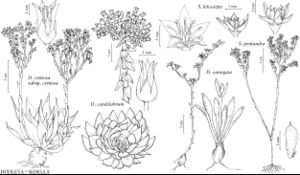Sedella
New N. Amer. Crassul., 45. 1903 ,.
Herbs, annual, not viviparous, 0.2–1 (–1.3) dm, glabrous. Stems erect, simple or branched, succulent. Leaves deciduous by anthesis, cauline, opposite near base, alternate distally, ± alike, sessile, not connate basally; blade oblong-ovoid to obovoid, laminar, 0.4–0.7 cm, succulent, base spurred, margins entire; veins not conspicuous. Inflorescences terminal cymes. Pedicels: flowers subsessile. Flowers erect, 5-merous; sepals connate basally, all alike; petals spreading, ascending, or erect, connate basally, nearly distinct, straw colored to bright-yellow or greenish yellow, sometimes marked with red; calyx and corolla not circumscissile in fruit; nectaries clavate; stamens as many or 2 times as many as sepals; filaments adnate to corolla base; pistils erect, distinct; ovary base rounded; styles 2+ times shorter than ovary. Fruits utricles, erect or ascending, sometimes appressed. Seeds oblong-clavate, ribbed. x = 9.
Discussion
Parvisedum R. T. Clausen
Species 3 (3 in the flora).
Sedella is distinctive in its solitary basal seeds, each in an indehiscent utricle. The plants are often red or reddish. In two species, the utricles have sticky glands that may help dispersal; also, they float in water. Despite some reports, every species has a nectary at the base of each pistil, as in most Crassulaceae.
Clausen proposed the name Parvisedum because he thought Sedella Fourreau of 1868 to be an earlier homynym, but U. Eggli (1992) pointed out that Sedella Fourreau was not validly published. However, Á. Löve and D. Löve (1985) have used “Sedella” in the sense of Fourreau.
Selected References
None.
Lower Taxa
Key
| 1 | Stamens 10; flowers 4-10 mm diam., petals widely spreading, erect in fruit; styles 0.3-1.2 mm. | Sedella pumila |
| 1 | Stamens 5; flowers 2-4 mm diam., petals erect or ascending, sometimes appressed in fruit; styles 0.2-0.4 mm | > 2 |
| 2 | Pistils subglabrous; petals 2.5-3.5 mm; calyx bases tapering to pedicels; seeds 1-1.3 mm. | Sedella leiocarpa |
| 2 | Pistils stipitate-glandular; petals 1.5-2 mm; calyx bases thickened for 1 mm; seeds 0.7-0.9 mm. | Sedella pentandra |
"dm" is not declared as a valid unit of measurement for this property.
